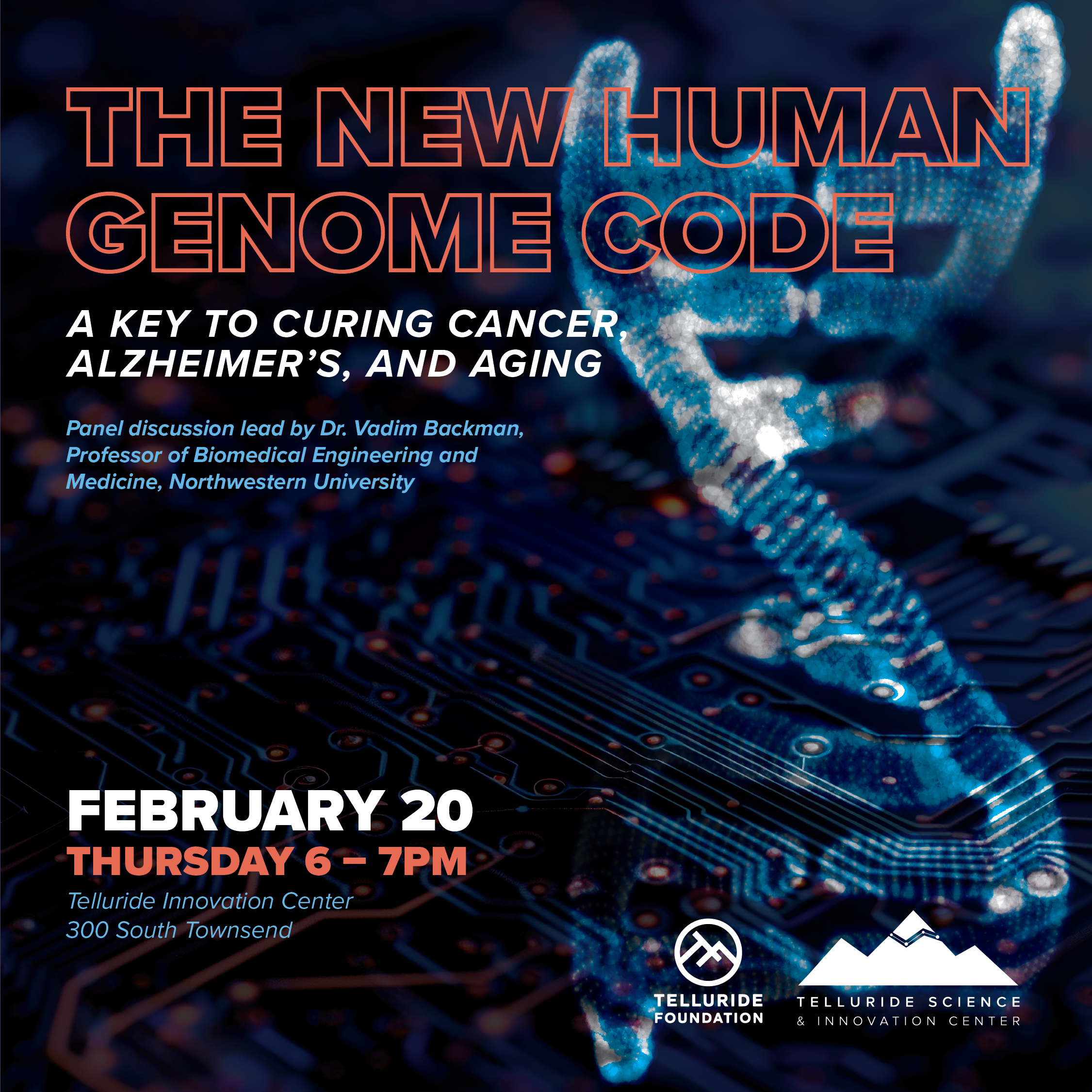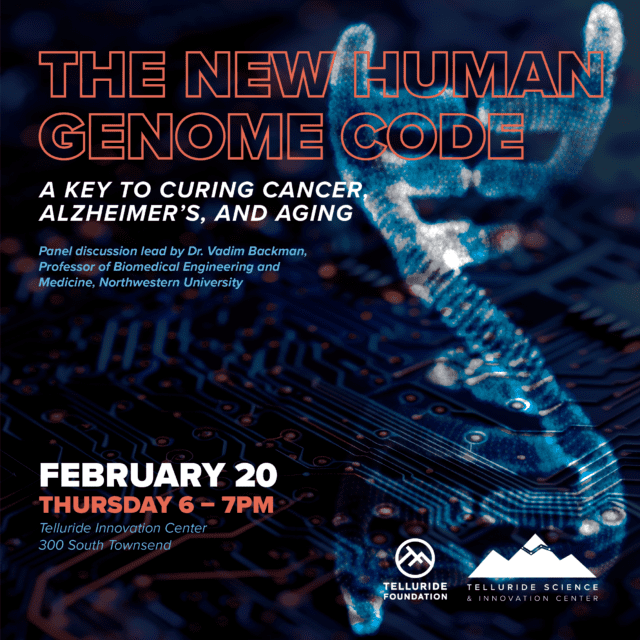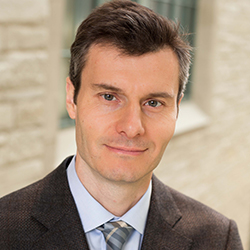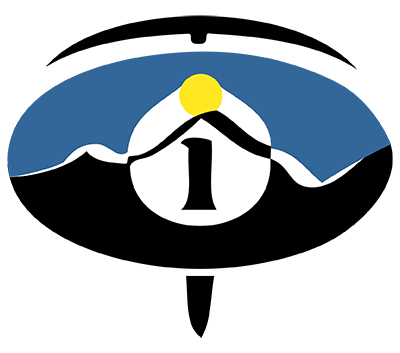
29 Jan Telluride Science & Foundation: “New Human Genome Code, A Key to Curing Cancer, Alzheimer’s & Aging!” 2/20!
The Telluride Foundation and Telluride Science are co-hosting a talk titled “The New Human Genome Code, A Key to Curing Cancer, Alzheimer’s, and Aging,” The event takes place Thursday February 20, 2025, 5:30 – 7 p.m., at Telluride Science’s new home: The Depot, 300 South Townsend Street.
Click here to reserve your spot.
Go here for more about the Telluride Foundation (back to 2009).
Go here for more about Telluride Science.

The idea of sequencing the entire human genome arose in the U.S. in the mid-1980s. Ultimately the project was launched in October 1990 and completed in April 2003. The goal? Mapping and sequencing our genome or “reading” the complete set of genetic instructions in human DNA to identify all our genes in order to understand their diverse functions. The hope was that the findings would lead to advancements in disease diagnosis and treatment. And, in the end, the project did enhance medical research, coupling certain genes with various maladies, which opened doors to personalized medicine and genetic therapies.
But were those findings accurate? Did the Human Genome Project go far enough in the right direction?
No. At least not according to a recent, potentially groundbreaking study initiated by Telluride Science.
The new study, conceived at a series of Telluride Science workshops, brought people with drastically different types of expertise, from biology to physics to engineering and AI, and established a breakthrough in the field.
Telluride Science board member, Dr. Vadim Bachman, was a major actor in the workshops and in the subsequent in-depth study which ultimately revealed that the human genome is far more dynamic than previously thought.
Turns out our genome operates less like a static instruction manual and more like a sophisticated, physically encoded computer that integrates signals to form 3D structures essential for cell function. And like a computer, scientists may soon be able to “reprogram” these cellular memories to create radically new strategies for human wellness.
On Thursday, February 20, Dr. Vadim speaks on the subject of “The New Human Genome Code, A Key to Curing Cancer, Alzheimer’s, and Aging.” The event, hosted by Telluride Science and the Telluride Foundation, is free and open to the public and. takes place at the Telluride Innovation Center (formerly The Depot). A donor reception is scheduled from 5 – 5:45 p.m.; Dr. Vadim’s talk, 6 – 7 p.m.
Before doing a deep dive into Vadim & Co.’s research let’s pull back to the basics. What exactly is the human genome? And what are the abiding beliefs about the genome that might die a quick death based on his team’s findings?
According to Vadim, the genome is the combination of all our genes. How our genes encode proteins – genes are transcribed in mRNA, and mRNA is translated in a protein – has been deeply studied and very well understood. However, the fact that every human cell caries the same genes has major ramifications.
“How do some cells differentiate into so many different cell types, which requires transcription of different genes despite us all having the same genes in our cells? Why do so many cells have altered expression when they age and can no longer perform their function? These questions were not answered by the Human Genome Project. Our study identified a new cellular memory code that finally provides credible answers. And now that we finally know what the code is, we can begin to work on reprogramming. What this means is that we should be able to rejuvenate cells, make them perform their original function correctly, regrow organs, and prevent or reverse diseases such as dementia and Alzheimer’s, also cancer and other challenges of aging. In other words instead of the genome acting as a storage bin for information, we found that it operates more like a dynamic computer processor that integrates the intended signals with what the available space can allow.”
Turns out the genome stores cellular memory in structural units called domains. Vadim’s team is now developing technologies to disassemble or assemble specific domains to restore the correct cell memory. His study also highlights how cells use transcriptional memories to establish predictable, stable behaviors within tissues.
But exactly what are transcriptional memories and why does understanding them at a deeper level have the potential to positively impact the aging process and diseases in general, including but not limited to cancer, Alzheimer’s, atherosclerosis, cognitive decline, and muscle loss? Also how does our chromatin or the genetic material that makes up chromosomes fit into this evolving and very exciting story?
“In a few words, the main finding is the origin of cellular transcriptional memory. As mentioned, every cell in our bodies has the same genes, but some cells turn in neurons, others into muscle and 200 other cell types.Transcriptional memory turns genetic information into cell behavior and phenotypes. Genetic memory is encoded chemically by DNA nucleotides (A, T, C, G). What we showed is that transcriptional memory is encoded in 3D structural elements (instead of chemical encoding): chromatin nanoscale domains. Each cell has several thousand of these memory elements which can be created, but degrade over time. The system is emergent and has properties of reinforcement learning, similar to the neuronal network reinforcement learning we program in AI algorithms. The practical significance of the findings is that now that we are beginning to understand how transcriptional memory is encoded and the precise Rules that regulate it, we can begin to design strategies or rationally (as opposed to empirically) design cellular memory states to regulate cell behavior. Most human diseases, including aging, cancer, atherosclerosis, and Alzheimer’s, involve reprogramming of transcriptional memory. Understanding the Rules of the system will allow us to reprogram these life-changing processes.”
What were the technological breakthroughs that made this human genome 2.0 study possible?
“Our team used state-of-the-art technologies such as CRISPR, but also developed new technologies including nanoscale imaging and computational modeling,” explained Vadim. “And, yes, we did have to derive a lot of equations to predict how the genome works.”
The new genome study also postulates that its findings raise intriguing questions about evolution and biology across species.
“The ability of a cell to create complex memories, rooted in the genome structure, is what allowed complex life to appear. It is one of the critical events in evolution, along with the creation of a cell, genes, eukaryotic cells, and oxygen metabolism (and the atmosphere). Genomes of complex organisms had to acquire a lot of “junk” DNA exactly in the right places to allow for domain formation. That took a lot of time to evolve and was likely facilitated by viruses. Just like we are taking advantage of our symbiotic bacteria, our ancestors took advantage of viruses to deposit junk DNA in right places. Having domains and cell memory also guide where to create the gene mutations that guide evolution. Both cell memory and gene mutations are a self-learning system.”
Again Dr. Vadim & Co’s impressive study, filled with promise, would not have happened without Telluride Science.
“Without Telluride Science I would not be doing what I do now,” concluded Vadim.”National Institute of Health (NIH) would not have recognized and funded physical genomics as an important stand-alone field, yet physical genomics holds great promise to revolutionize medicine and how disease is treated. Here in Telluride the energy landscape changed dramatically from the mining industry with the creation of the first AC power plant and now it is where a lot of the very exciting science is happening. Innovations in this box canyon started 100 years ago and continue today. Once a scientist told me there were two instances in his life when he felt like a child with eyes wide open. Everything felt possible. The first time was when he went to a top researching institute and the second time was at a Telluride Science workshop. The power of Telluride Science is mind-blowing. There is no structure or organization like this anywhere else in the world.”
Dr. Vadim Bachman, more:

Dr. Vadim Bachman, courtesy Northwester Univerity.
Dr. Vadim holds is a Ph.D. Medical Engineering and Medical Physics, Harvard University-MIT, Cambridge, MA; MS in Physics, MIT, Cambridge, MA; an M.S. in Physics, St. Petersburg Polytechnic Institute, St. Petersburg, Russia; and a B.S. Physics (Hons), St. Petersburg Polytechnic Institute, St. Petersburg, Russia.
Today Dr. Vadim is professor of biomedical engineering and medicine. His research bridges physical genomics, imaging, computational biophysics,
Go here for way more detail. https://www.mccormick.northwestern.edu/research-faculty/directory/profiles/backman-vadim.html
Telluride Science, more:
Visit telluridescience.org to learn more about Telluride Science and the capital campaign to transform the historic Telluride Depot into the Telluride Science & Innovation Center. The venue is now the permanent home for Telluride Science and a global hub of inspired knowledge exchange and development where great minds get to solve great challenges.
Telluride Foundation, more:
The Telluride Foundation is committed to enriching the quality of life of the residents, workforce, and visitors of the Telluride region. It is a nonprofit, apolitical community foundation that makes grants and runs programs in arts, education, health and human services, community development, and social enterprises.The Foundation strives to achieve excellence for the community through its mission and core values of inclusion, self-reliance, and innovation. The work is funded through the generous support of hundreds of donors and grants from state and national foundations. Visit telluridefoundation.org.


Sorry, the comment form is closed at this time.